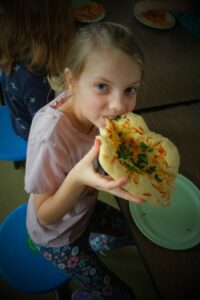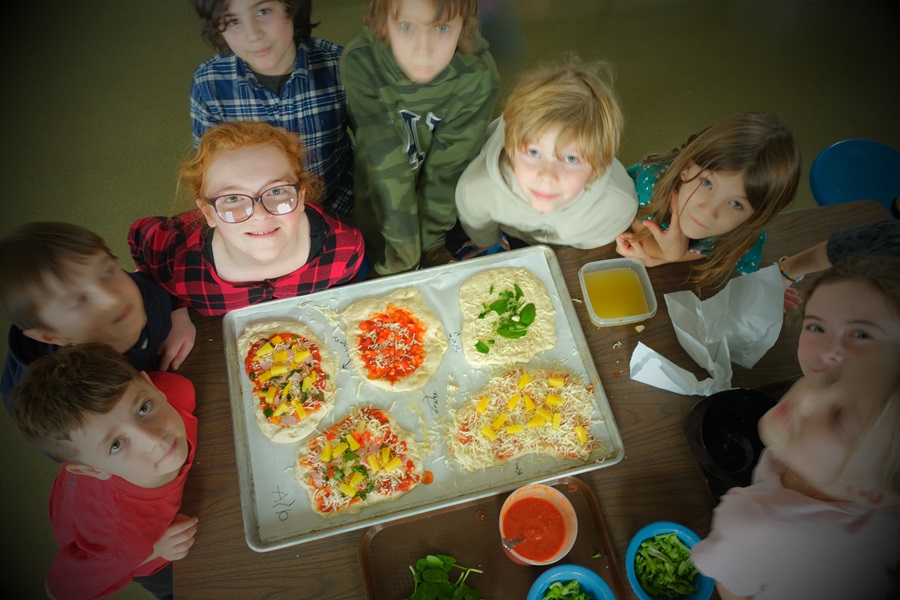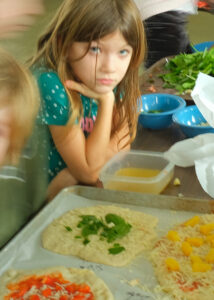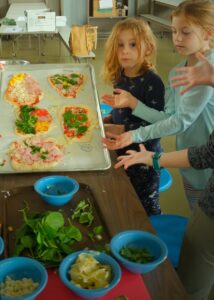Students in the Wellfleet Elementary School’s culinary club have, over the past month, stayed after school to make things many of them had never heard of, like pho, the Vietnamese soup, or overnight oats with chia seeds. But on this late January Thursday, Claudia Crosen, the school nurse who runs the club, is playing to her audience: it’s pizza day.
There’s a catch, though: “You have creative license to put whatever you want on your pizza,” Crosen says, “but I’m going to challenge you to put on one thing you haven’t had before.”

Spread around two tables in the school cafeteria, the students are cutting up ingredients for the toppings, including red peppers, artichoke hearts, jalapeños, garlic, broccoli, and ham. They sample freely from the piles of toppings before committing to what they’ll add to their pizzas.
“I can handle it,” says fifth-grader Sinia Winslow after popping a slice of jalapeño into her mouth. “I really like spicy,” she says, adding that she was given a garlic hot sauce for Christmas that she likes to use on veggie burgers at home.

Arlo Baghetti, a second grader, also tries the jalapeño. “It’s not spicy,” he says. A moment later he rushes to find a water bottle as his face turns red. “I liked it, but it was really spicy,” he explains.
“I’m exposing kids to things that taste good and that they might not have tried before,” says Crosen after the class. “With the jalapeños, we had some kids whose eyes and lips were burning. It’s a learning experience.”
Huey Hughes, a second-grader, is taking a smaller step into new culinary territory. “I usually eat cheese pizza,” he says, but this time he’s adding ham to his pie — an ingredient Crosen chose for its lower sodium content, at least compared to pepperoni. “I think it might taste good,” he says optimistically, as he puts together his pizza with sauce and fresh dough donated by Pizza Spinello.
Hughes came to the class without much cooking experience. “I wanted to try something new,” he says. So far, pho has been his favorite. “We made noodles, and I put soy sauce in it,” he says.

Lily Kinshaw shares Huey’s enthusiasm for pho, which includes tofu, broccoli, ginger, and garlic. She brought the recipe home and made it for her family. “They said they loved it,” says Lily, who is in fifth grade. “I like giving people the satisfaction of eating good meals,” she adds.
Today Lily is chopping the red peppers for her pizza fine, showing a strong command of the knife. “We practice basic knife skills,” says Crosen. “All these things are important.” Crosen is confident the students can learn the skills of the kitchen. “In our culture we tend to do too much for our children,” she says.
The cooking club is one of several after-school enrichment programs at the school. Clubs run weekly for six weeks and are taught by school staff, parents, and community members. Besides the culinary club there are others focused on international cultures, board games, and art.

Crosen’s culinary club reflects her own love of cooking, something she wanted to share with the kids. Aside from working as a school nurse, she picks up occasional catering gigs with Angel Foods in Provincetown. “I do it to relax,” says Crosen. “It’s something I enjoy.”
She also sees the club as part of a larger mission to improve the health of young people. “There’s such a link between long-term health outcomes and what you put in your body as a kid,” says Crosen. She rattles off a list of ailments linked to poor nutrition: obesity, type 2 diabetes, high blood pressure, and cardiac disease.
Adjusting the school’s menu with nutrition in mind has proved unwieldy, though. First, there are the U.S. Dept. of Agriculture’s rules, which come with the federal funding schools receive for food. These dictate the necessary components of a meal. The problem, says Crosen, is that “children are required to take a fruit, a vegetable, a protein, and a dairy product, whether or not they are going to eat it.”

Although the restrictions appear balanced, Crosen doesn’t think they’re effective in achieving optimal nutrition. “I don’t think they ensure better health for the child,” she says emphatically.
The menu at Wellfleet Elementary is a district-wide one, put together by Susan Murray, the director of food and nutrition services at Nauset Public Schools. USDA rules, food costs, and supply constraints also influence what is served each day. The cafeteria serves things like chicken lo mein and roasted turkey, and with sides like steamed carrots, brown rice, and corn on the cob, nutritious options are available. But, overall, the menu is a mixed bag of nutritional value: there are also tater tots, mac and cheese, chocolate milk, ranch dressing, and chicken patties.
For Crosen, the after-school cooking class offers some satisfaction as a workaround. Although the USDA might not offer optimal flexibility in menu planning, it did give the school district a Healthy Meals Incentive Grant — nearly $150,000 is funding the culinary club, among other initiatives, including the purchase of hydroponic growing systems in each of the seven schools in the Nauset district.

The two garden towers in the school cafeteria should produce around 25 pounds of lettuce every 28 days. “That will cover all our needs for greens,” says Crosen. “I’d like to offer greens at every lunch and introduce a citrus-based dressing that doesn’t have a lot of oil.”
For most of the students, the path to eating fresh greens with a citrus dressing is a gradual one. Many of the younger students were moving away from cheese pizza for the first time at the club’s session last week. Like Huey Hughes, Grace Brencher, a second-grader, was trying a different topping for the first time: her choice was red pepper. And while Sinia’s white pizza with spinach, jalapeño, and green onions made her seem like a foodie, she eschewed the artichoke hearts, which were left in a pile on a cutting board.
“I didn’t have a lot of artichoke eaters,” says Crosen, who was unfazed by the leftovers. “Nobody has to eat something that they don’t like. But I really encourage the ‘no thank you’ bite.”